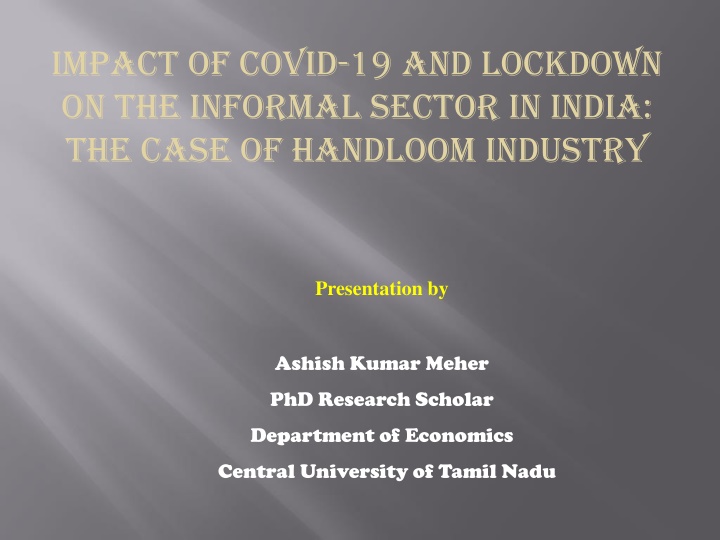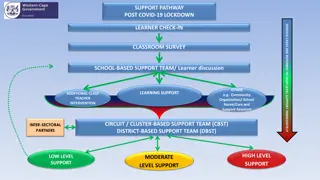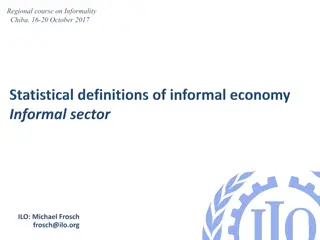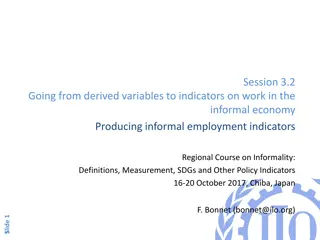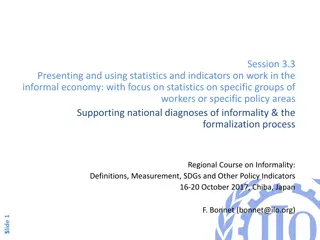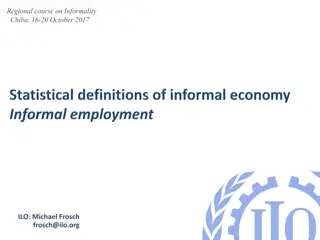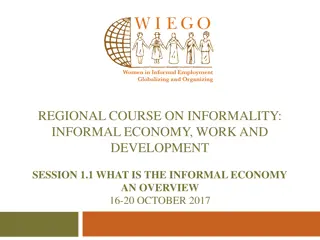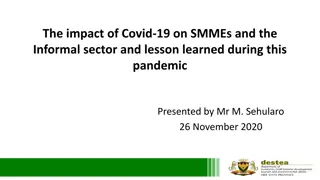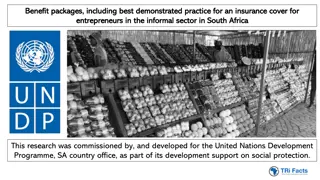Impact of COVID-19 and Lockdown on the Informal Sector in India: The Case of Handloom Industry
The COVID-19 pandemic and subsequent lockdown severely impacted India's handloom industry, affecting production, employment, and income. This presentation explores the challenges faced by informal sector workers, particularly handloom weavers, and highlights the industry's significance to the economy. It discusses the disruptions caused by the pandemic, such as unavailability of raw materials and closure of markets, leading to economic hardships for weavers.
Download Presentation

Please find below an Image/Link to download the presentation.
The content on the website is provided AS IS for your information and personal use only. It may not be sold, licensed, or shared on other websites without obtaining consent from the author.If you encounter any issues during the download, it is possible that the publisher has removed the file from their server.
You are allowed to download the files provided on this website for personal or commercial use, subject to the condition that they are used lawfully. All files are the property of their respective owners.
The content on the website is provided AS IS for your information and personal use only. It may not be sold, licensed, or shared on other websites without obtaining consent from the author.
E N D
Presentation Transcript
Impact of COVID-19 and Lockdown on the Informal Sector in India: The Case of Handloom Industry Presentation by Ashish Kumar Meher PhD Research Scholar Department of Economics Central University of Tamil Nadu
Contents Introduction Literature Review Research Gap and Objectives Data Sources and Methodology Analysis and Discussion Conclusion
Introduction The unprecedented nationwide lock down in India adversely affected the Indian economy as production, distribution, employment and income was completely shut except some essential commodities and services. Though the pandemic has affected almost every sector of the economy resulting in loss of livelihood across social divide in India, the informal sector workers have been the most affected as they lack employment protection and social security. In the informal sector, the handloom industry provides employment on such a large scale that it stands second next only to agriculture. The handloom industry is very important to the Indian economy in terms of output, export and employment generation.
Continued The industry is capable of providing employment opportunities to large unskilled and semiskilled workforce in the rural and semi- urban areas. The handloom products of India are highly acknowledged all over the world due to its exquisite design and excellent colour combinations. But, the handloom weavers hardly get sufficient remuneration for their labour and hence live a miserable life due to negligence to this sector. The COVID-19 lockdown disproportionately affected the weavers due to unavailability of raw materials, inflated price of yarn and dyes and closure of markets.
Literature Review Meher R. (1995) analysed the problems and prospects of handloom industry and the living conditions of weavers in Orissa. He found out that the weavers live in ill-standard houses with inhospitable working conditions. Sharma S. (2004) stated that poor designs, sick institutional linkages, technological constraints, low value addition, lack of innovation and entrepreneurship, static weavers skill and lack of working capital are the major problems faced by the handloom weavers in Pochampally. Goswami and Jain (2014) observed that insufficient supplies of yarn, lack of marketing and sales networks are the major constraints in the way of sustainable development of handloom industry in Jaipur district of Rajasthan. Nagaraju and Rao (2014) observed that the preference level for weaving as an occupation among the youth is zero. The educational, health and dwelling status of the handloom weavers is very poor but it is worthy to note that most of the handloom weavers have adequate sanitation facilities.
Continued Shafi et. al. (2020) stated that as an impact of COVID-19 pandemic the MSMEs in Pakistan are mainly facing financial issues, supply chain disruption, decrease in demand, reduction in sales and profit etc. Das and Sutradhar (2020) examined the condition of the handloom weavers especially women during lockdown in Sualkuchi cluster of Assam and revealed that looms fell silent due to lockdown and hence it left the workers without any work and payment. Komin et. al. (2021) found out that the informal sector (IS) workers in Thailand experienced drastic decreases in their monthly income though the reduction in come varied across occupations and geographic regions. Kesar et. al. (2020) observed that the COVID-19 pandemic and lockdown resulted in massive increase in unemployment, dramatic fall in earnings, large increases in food insecurity, depletion of savings and patchy coverage of relief measures among the informal workers in India.
Research Gap and Objectives Not many studies have been conducted to analyse the problems and prospects of the informal workers in the handloom industry. Also, study on examining the impact of COVID-19 pandemic on the handloom weavers is very rare. Therefore the present study attempts To analyse the manifold problems faced by the handloom weavers in this sector before lockdown. To investigate the impact of COVID-19 on the lives and livelihood of the handloom weavers in India.
Data Sources and Methodology Data on different issues being faced by the handloom weavers is taken from the reports of National Handloom Census 2019, Annual Reports of Ministry of Textiles- Government of India, journal articles and web sources. Information on major problems encountered by the weaver households during lockdown was gathered from the print and electronic media and news pieces. A small primary study was conducted to understand and verify the microeconomic impact of COVID-19 on the handloom weavers. The study consisting of 15 handloom weaving households was conducted at a major handloom pocket named as Bijepur in the Bargarh district of Odisha state. The field study was conducted in the first week of August 2021 using semi structured questionnaires, interviews and observation method. The data was processed in Ms-Excel and qualitative descriptive statistics were used to analyse the data.
Analysis and Discussion: Issues being faced by the Handloom Weavers Dwelling Types: Kuccha houses- 60.2%, Pucca houses- 21.2%, Semi pucca houses- 18.7%. Income Generation and Acuteness of Poverty: 67.1% handloom worker households are having income of below Rs.5000 per month which means that the households are earning below Rs.166 per day. Around 25% households are the poorest of the poor. Production System and Marketing Strategies: Independent weavers- 73.2%, Under master weavers- 19%, Under institutions- 7.4%.
Continued Technological Development: Pit looms with dobby/jacquard and other pit looms- 42.2%, dobby/jacquard and other frame looms- 31.5%, Loin looms and others- 26.3%. Frame looms with Government Assistance: 65% of the weaver households are not aware of the existing schemes.
Impact of COVID-19 and Lockdown: Secondary Evidence According to Business Today coronavirus pandemic has severely affected exports of cotton yarn, fibres and garments in West Bengal. At the same time handloom weavers and artisans have been hit hard by slump in sales due to lockdown restrictions. Weavers and craftsmen are facing wage loss as their businesses have come to a standstill . As per The Times of India Many weavers of Bargarh district depend on the open markets for sale of their handloom products. But they have been unable to sell the fabrics owing to lockdown now. More than 12000 families of this region depend on weaving activities to earn their livelihood which has been impacted badly as the markets are shut .
Continued The New Indian Express described since the COVID-19 pandemic and subsequent lockdown, looms of these weavers have stood still in Gadag district. Over 6,000 skilled workers are hired by the traditional weaving sector in this region. These skilled workers, who have worked at the looms for generations, have been hit hard by the current circumstances . Covid-19 lockdown has impacted the weavers as hundreds of looms producing Pochampally Ikkat clothes, went silent in erstwhile Nalgonda for the last two months. Stocks of Ikkat sarees, worth Rs.200 crore accumulated with master weavers due to lack of marketing facility during lockdown reported Telengana Today. The New Indian Express wrote up hit hard by the coronavirus-induced lockdown, 'Himroo' weavers in Maharashtra's Aurangabad district are waiting for return of foreign tourists the prime customers of their products, and full-fledged start of normal activities for revival of their business.
Impact of COVID-19 and Lockdown: Primary Evidence 90% of the respondents completely lost their livelihood for an average of six months in different phases of lockdown in India. As the markets were closed the independent weavers were neither able to buy raw materials nor able to sell their finished products. The weavers working under master weaver/ middleman reported to have received less than 30 per cent of their wages and irregularity in work. The cooperative society believed to be helpful for the handloom weavers also could not cope with the lockdown, shutdown measures and could not provide complete protection of employment to the weavers.
Continued The total income loss of the handloom weavers since March 2020 is reported to be from INR 60,000 to INR 130,000. Due to lack of savings, most of the weavers encountered financial crunch to maintain their daily expenditure leading to high level of mental stress and trauma. As very few of them had past savings and most of them are debt burdened, their family was run by taking loans from village money lender and government mercy. Corona relief package of INR 1.70 lakh crore under Pradhan Mantri Garib Kalyan Yojana for the unorganised sector workers, especially daily wage workers, and urban and rural poor.
Continued The handloom weavers in the study area mostly received free ration and financial assistance to female Jan Dhan account holders. Some of them also received free cooking gas under Ujjwala scheme. Central Government announced a Corona Relief package of Rs.3 lakh crore in May 2020 to support the MSMEs but there is no specific scheme for the handloom sector. Financial help in terms of easy loan, work shed and proper implementation of the existing government schemes is necessary for the weavers in the current situation.
Conclusion Handloom workers are living in ill standard houses which is responsible for their poor health and unproductive working condition. They are having very low level of income resulting in acute poverty and hence malnutrition. The production and marketing techniques of the weavers are found to be unorganised, the technology used by them are out dated. Lack of government support and ignorance towards the handloom industry is making the life of the workers even more pathetic and desperate. COVID-19 and lockdown has hit hard to the handloom industry leaving the informal workers without work, income, food and other basic necessities. A huge income loss has been experienced by the workers and yet their situation has not improved. The corona relief measures are not adequate and hence there is urgent need of specific policies for the handloom weavers.
Thank You Thank You
